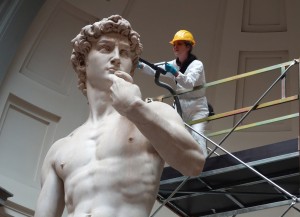The Spring Cleaning of Michelangelo’s David

What happens in Florentine museums on the day they’re closed to the public? The artworks get a good dustoff. But when the artwork in question is Michelangelo’s David, it becomes headline news.
“We dust the other statues a total of four times a year, but ‘His Majesty’ gets a treatment every two months,” says restorer Emanuela Peiretti. She and her colleague Paola Rosa use a series of soft brushes and a low-pressure vacuum cleaner to ever so gently remove the dust and dirt deposits that inevitably occur when there are so many visitors flocking to see the masterworks.
On February 29, 2016 at the Accademia an agreement was signed between the Museum’s new Director, Cecilie Hollberg, and the President of the Friends of Florence Foundation, Simonetta Brandolini d’Adda. The “Friends” have once again come to Florence’s aid, pledging a sum total of €20,000 in 2016 for the upkeep of the David, the other six statues by Michelangelo in the Accademia’s collection, and Giambologna’s clay model for the Rape of the Sabine Women.
In the last 14 years, Friends of Florence have contributed over € 500,000 towards the conservation of both paintings and statues at the Accademia.
“We realized when we sponsored the restoration of the David in 2003 in preparation for his 500th anniversary, that preventative maintenance was a key factor for the proper conservation of the sculpture. We have been able to maintain this long term commitment,” says Brandolini d’Adda.
Simonetta Brandolini d’Adda is also confident that Friends of Florence would be able to raise the funds for a anti-seismic platform to protect the statue from earthquakes, and she is eagerly looking forward to seeing plans for this project advance.
By taking care of the David every two months, restorers are able to closely monitor the statues’ condition and to record any changes to the surface of the marble. According to the Director of the Accademia the statue is in good condition and the micro-fractures in David’s ankles and in the tree trunk behind his right leg are stable.
Concerns for the statue’s stability have been raised over the years, due to defects in the marble block itself and almost four centuries of exposure to the elements in the statue’s original location outside the Palazzo Vecchio. In 2014, scientists from CNR and the University of Florence created plaster test models of the statue, which they subjected to centrifugal force.
Based on their test results, they believe that the micro-fractures in the marble are the result of the gradual settling of the base on which the 5.5 ton statue rested in Piazza della Signoria, which eventually caused it to lean forward at an angle about five degrees off the vertical. This exerted pressure on the lower weight bearing parts of the statue, causing tiny fissures to appear. (elizabeth wicks)
